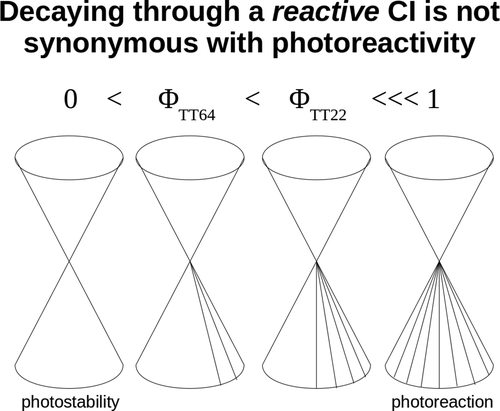当前位置:
X-MOL 学术
›
J. Phys. Chem. Lett.
›
论文详情
Our official English website, www.x-mol.net, welcomes your
feedback! (Note: you will need to create a separate account there.)
On the Intrinsically Low Quantum Yields of Pyrimidine DNA Photodamages: Evaluating the Reactivity of the Corresponding Minimum Energy Crossing Points.
The Journal of Physical Chemistry Letters ( IF 4.8 ) Pub Date : 2020-06-03 , DOI: 10.1021/acs.jpclett.0c01264 Angelo Giussani 1 , Graham A Worth 1
The Journal of Physical Chemistry Letters ( IF 4.8 ) Pub Date : 2020-06-03 , DOI: 10.1021/acs.jpclett.0c01264 Angelo Giussani 1 , Graham A Worth 1
Affiliation

|
The low quantum yield of photoformation of cyclobutane pyrimidine dimers and pyrimidine–pyrimidone (6–4) adducts in DNA bases is usually associated with the presence of more favorable nonreactive decay paths and with the unlikeliness of exciting the system in a favorable conformation. Here, we prove that the ability of the reactive conical intersection to bring the system either back to the absorbing conformation or to the photoproduct must be considered as a fundamental factor in the low quantum yields of the mentioned photodamage. In support of the proposed model, the one order of magnitude difference in the quantum yield of formation of the cyclobutane thymine dimer with respect to the thymine–thymine (6–4) adduct is rationalized here by comparing the reactive ability of the seam of intersections leading respectively to the cyclobutane thymine dimer and the oxetane precursor of the thymine–thymine (6–4) adduct at the CASPT2 level of theory.
中文翻译:

关于嘧啶DNA光损伤的固有低量子产率:评估相应的最小能量交叉点的反应性。
DNA碱基中环丁烷嘧啶二聚体和嘧啶-嘧啶酮(6–4)加合物的光形成的量子产率低通常与存在更有利的非反应性衰变路径以及以良好构象激发系统的可能性不同有关。在这里,我们证明了反应性圆锥形相交将系统带回到吸收构象或光产物的能力必须被视为上述光损伤的低量子产率的基本因素。为了支持建议的模型,
更新日期:2020-07-02
中文翻译:

关于嘧啶DNA光损伤的固有低量子产率:评估相应的最小能量交叉点的反应性。
DNA碱基中环丁烷嘧啶二聚体和嘧啶-嘧啶酮(6–4)加合物的光形成的量子产率低通常与存在更有利的非反应性衰变路径以及以良好构象激发系统的可能性不同有关。在这里,我们证明了反应性圆锥形相交将系统带回到吸收构象或光产物的能力必须被视为上述光损伤的低量子产率的基本因素。为了支持建议的模型,











































 京公网安备 11010802027423号
京公网安备 11010802027423号